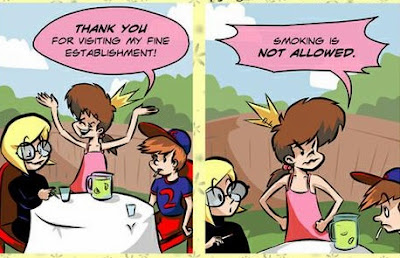I've been watching the Mad Max movies. Well, sort of watching them -- they're 90% Wacky Races, colorful post-Apocalyptic figures in weird cars chasing each other through the Australian desert.
With an obvious good vs. evil plotline, and guess what? The good guys are all patiently described as straight, and the bad guys as over-the-top gay.
Mad Max (1979), set in an Australia that just started to break down, pits good, noble, uber-heterosexual Family Man Max, who has a wife and daughter, against an outlaw gang of mohawk-haired gay guys who hug and kiss all over each other.
Oddly enough, Max wears a leather-fetish outfit that looks like it belongs on Folsom Street.
Mad Max 2: The Road Warrior (1981), is set about 10 years after the Apocalypse, with the kind, gentle, white-clad, and uber-heterosexual residents of Gasoline Town hounded by a gang of post-Apocalyptic gays. Their leaders look like refugees from Folsom Street.
There's also an explicit gay couple, the psycho Wezand and his boyfriend//slave, the Golden Youth, who gets killed.
The heterosexuals escape and flee north to a heterosexual future.
Mad Max: Beyond Thunderdome (1985), the only one of the franchise I saw at the time of its release, stars gay-fave Tina Turner as Aunty Entity, leader of an evil Bartertown full of grotesque gay men.
By now AIDS is in the news, so the gay men are all diseased, like this leather-clad, tattooed Angry Anderson with his drag-queen totem.
But Max shuts it down, with the help of a group of kids and hunky teenagers living in a heterosexual Blue Lagoon Paradise. They fly off to the fabled Tomorrow-morrowland and a heterosexual future. In the last scene, they've all reproduced.
How many different ways are there to demonize gay people?
Looks like three.
Beefcake, gay subtexts, and queer representation in mass media from the 1950s to the present
Jul 18, 2015
Jul 13, 2015
The Sacrifice of Isaac
One of the most horrifying stories in the Bible is the Sacrifice of Isaac (Genesis 22).
You probably remember it: God tells Abraham to kill his son. So he takes Isaac out into the woods, ties him up, raises the knife -- then, at the last moment, an angel appears and says something like "Hah, hah, fooled you -- God was just kidding! Here's a lamb for you to kill instead!"
When I was a Nazarene, no Sunday school teacher or preacher ever tried to explain the historical/cultural context of the story, how human sacrifice was commonplace, and some gods, such as Dagon, actually did demand children.
They didn't try to distinguish Abraham's act from the many crazy things people did today because "God told me to." Or wonder about what kind of God would play such a dirty trick.
Instead, they just praised Abraham for his unquestioning obedience, and drew a parallel with Jesus: . God wants to kill every one of us, but Jesus offered to take our place, so God killed him instead.
That didn't make me feel more comfortable.
I found it a example of the savagery beneath the heterosexist imperative: everyone said that fathers were wise, loving, and benevolent, but at any moment they could turn violent. And then say God told them to.
That didn't make me feel more comfortable, either.
According to the Biblical account, Isaac was sixteen years old at the time, already an adult in the eyes of his community. But the Sunday school teachers and preachers always envisioned him as a very little boy, too young to understand what was going on.
I preferred the illustration in my Children's Story Bible (top photo): a very muscular, grown-up Isaac with a handsome teen-idol face, naked except for a little white cloth, tied up with his arms behind his back, like Bomba the Jungle Boy.
Other artists have generally depicted a grown-up Isaac: an ideal opportunity to paint muscular male bodies. Gregorio Lazzarini shows Isaac fully nude, and transforms Abraham into a muscle daddy.
Jacopo Ligozzi's version (left) even has a penis showing.
See also: Bible Beefcake.
You probably remember it: God tells Abraham to kill his son. So he takes Isaac out into the woods, ties him up, raises the knife -- then, at the last moment, an angel appears and says something like "Hah, hah, fooled you -- God was just kidding! Here's a lamb for you to kill instead!"
When I was a Nazarene, no Sunday school teacher or preacher ever tried to explain the historical/cultural context of the story, how human sacrifice was commonplace, and some gods, such as Dagon, actually did demand children.
They didn't try to distinguish Abraham's act from the many crazy things people did today because "God told me to." Or wonder about what kind of God would play such a dirty trick.
Instead, they just praised Abraham for his unquestioning obedience, and drew a parallel with Jesus: . God wants to kill every one of us, but Jesus offered to take our place, so God killed him instead.
I found it a example of the savagery beneath the heterosexist imperative: everyone said that fathers were wise, loving, and benevolent, but at any moment they could turn violent. And then say God told them to.
That didn't make me feel more comfortable, either.
I preferred the illustration in my Children's Story Bible (top photo): a very muscular, grown-up Isaac with a handsome teen-idol face, naked except for a little white cloth, tied up with his arms behind his back, like Bomba the Jungle Boy.
Other artists have generally depicted a grown-up Isaac: an ideal opportunity to paint muscular male bodies. Gregorio Lazzarini shows Isaac fully nude, and transforms Abraham into a muscle daddy.
Jacopo Ligozzi's version (left) even has a penis showing.
See also: Bible Beefcake.
Jul 12, 2015
The Princess: Sometimes Boys are Girls
Sometimes boys are girls.
Eight-year old Sarah may have male physiology, but who cares? She has been telling her family that she is a girl since she learned to talk.
Her father and aunt are ok with the dresses, the female pronouns, and the name "Sarah." Her mother, not so much; she insists on boy-clothes and the name "Seth," hoping desperately that "it's just a phase."
Nope, not a phase. Sarah is a girl, and every girl has a right to be a Princess.
While Mom is busy fretting over her child's future of bullying, transphobia, loneliness, and angst, Sarah is negotiating grade school admirably.
She has a coterie of friends:
1. Irma, a cisgirl who likes superheroes, monster movies, and wearing boys' clothes (cis means that your physiology and gender identity match).
2. Jordan, a teenage transboy who sometimes babysits (Mom doesn't realize that he's trans)
3. Chuck, a cisboy with a crush on Sarah.
Actually, it's the non-trans-related situtions that make the strip. It's no big deal: Sarah is a girl. Any questions? Ok, then let's get on with the story. In this case, Sarah and her friends playing restaurant.
This is one of the funniest child-oriented comic strips out there, on a par with Soup to Nutz and Frazz.
And, with its G-rated humor, perfect for gender-atypical kids of any age (and gender-typical kids, too).
Christine Smith has been publishing the webcomic The Princess twice a week since 2009 (older strips are archived on The Duck). There's a collection available through Prism Comics.
See also: Dykes to Watch Out For.
Eight-year old Sarah may have male physiology, but who cares? She has been telling her family that she is a girl since she learned to talk.
Her father and aunt are ok with the dresses, the female pronouns, and the name "Sarah." Her mother, not so much; she insists on boy-clothes and the name "Seth," hoping desperately that "it's just a phase."
Nope, not a phase. Sarah is a girl, and every girl has a right to be a Princess.
While Mom is busy fretting over her child's future of bullying, transphobia, loneliness, and angst, Sarah is negotiating grade school admirably.
She has a coterie of friends:
1. Irma, a cisgirl who likes superheroes, monster movies, and wearing boys' clothes (cis means that your physiology and gender identity match).
2. Jordan, a teenage transboy who sometimes babysits (Mom doesn't realize that he's trans)
3. Chuck, a cisboy with a crush on Sarah.
Actually, it's the non-trans-related situtions that make the strip. It's no big deal: Sarah is a girl. Any questions? Ok, then let's get on with the story. In this case, Sarah and her friends playing restaurant.
This is one of the funniest child-oriented comic strips out there, on a par with Soup to Nutz and Frazz.
And, with its G-rated humor, perfect for gender-atypical kids of any age (and gender-typical kids, too).
Christine Smith has been publishing the webcomic The Princess twice a week since 2009 (older strips are archived on The Duck). There's a collection available through Prism Comics.
See also: Dykes to Watch Out For.
Subscribe to:
Comments (Atom)












